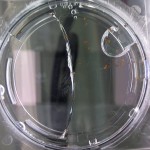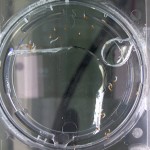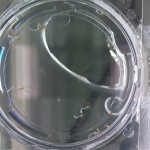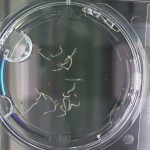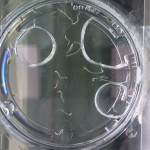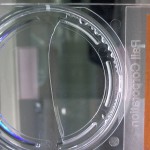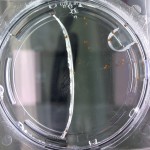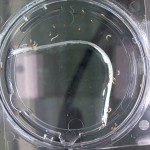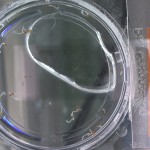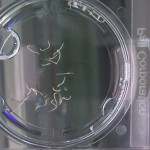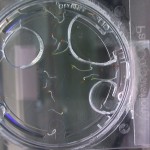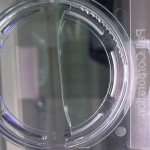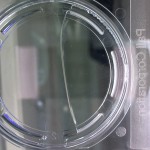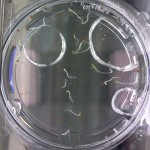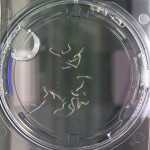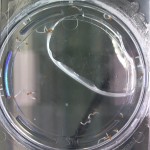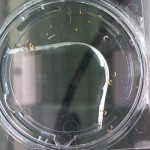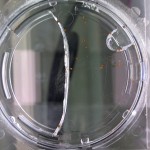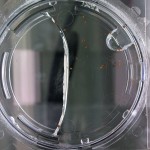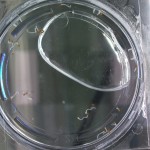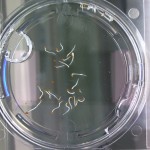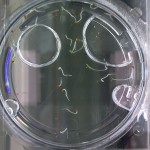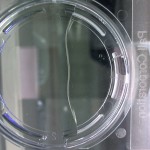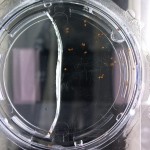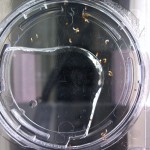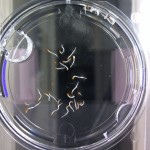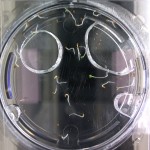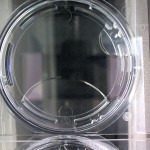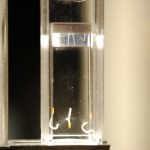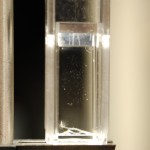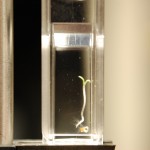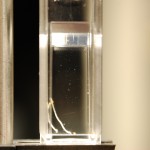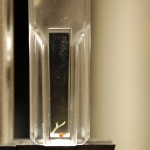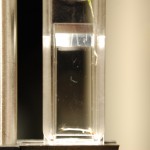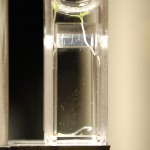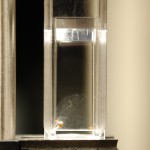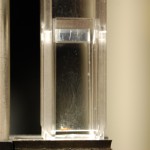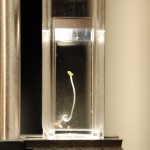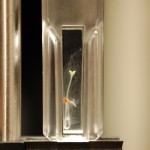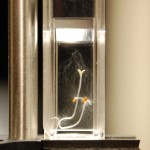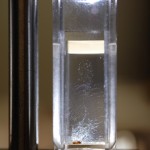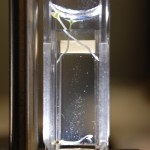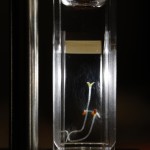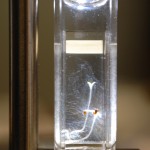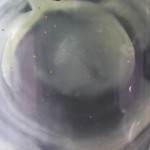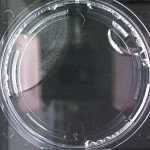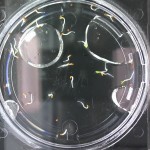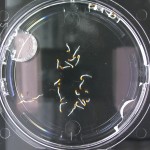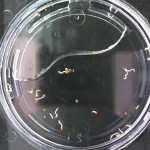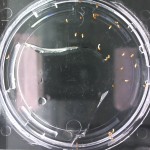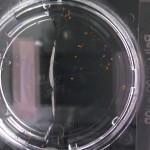I’m leaning towards doing this trial for 2 more days because all the seeds are at/approaching max germination. Beyond day 15 I’ll keep my eye on the D2O sample to see if there is any sprouting, but it looks like it is becoming a race against evaporation.
Tag Archives: tobacco seeds
Recreating Crumley: Day 12
Despite the tardiness of this post, I took these pictures yesterday at my normal time. I just had some time constraints so I didn’t post the images live.
Repeating Crumley: Day 11
Repeating Crumley: Day 10
Double Digit Days!
Repeating Crumley: Day 9
Nothing new to report. It looks like the 99% D2O seeds still haven’t sprouted which is what should happen (contrary to Crumley’s report). Everything else is growing as expected. And as usual there is nothing in the sample with no seeds.
Videos of the Root Hairs
Video 1 – (Download by right clicking and selecting save as ~40MB) This is the dark virginia seeds in ddw as viewed from the front of the cuvette.
Video 2 – (Download by right clicking and selecting save as ~18MB) This is the dark virginia seeds in ddw as viewed from the side of the cuvette.
Video 3 – (Download by right clicking and selecting save as ~25MB) This is the dark virginia seeds in tap water as viewed from the front of the cuvette.
Video 4 – (Download by right clicking and selecting save as ~34MB) This is the dark virginia seeds in ddw as viewed from the front of the cuvette, but I’m wiggling the cuvette holder so you can see the motion of the hairs and differentiate them from scratches on the glass.
Follow Up on Yesterday’s Final Results of Tobacco Seeds in Water
Here are all the pictures as promised from yesterdays presults (like that one?). Compare the first picture in the gallery to this one from the last update 15 days ago. Notice the amount of growth in the past 15 days.
While the seeds in ddw have kept growing, it appears the seeds in all other samples have either stopped growing, are growing slower, or are dying. This time most roots did not have hairs or had very little hairs, which is different from last time where the hairs were more obvious. I don’t know what to make of this for now.
I’m also not going to make any conclusions or assumptions in this post or any other observations for that matter. I’ll leave it up to you to think about what’s different and post observations in the comments. The one thing I will say though is that this study is fascinating!
I took some videos of the hairs which I will post in the next post.
Final Update on Tobacco Seeds in DDW
Well oh well. Look at what we have here. I’m so excited I can hardly contain myself…
…ahem.
So it’s been a while since I updated and that’s because I’ve pretty much left the seeds to their own accord. I didn’t want to end the experiment officially because I wanted to see if there would be any other startling results, but it was pretty much over. Now I think I got some startling results. Let’s talk about this:
- I took pictures of 3 different samples, one dark virginia in ddw, one dark virginia in tap water, and presoaked dark virginia in ddw. The pictures are lit (to see the results) using my new Droid Bionic camera led (for flash) as the lighting source.
- Two pictures are of the same sample. One is very well lit and the other is dark, but with some side light (I liked the way it looked artistically so I included it and made it the feature image). In these two images I wanted to illustrate that the seedlings were fully germinated (and probably at max growth submerged in water), but that the root hairs I adoringly refer to as root fro almost have completely filled the solution! What the hell could this mean? I no longer think it is a lack of nutrients. Why? Because this effect is only seen in the samples of ddw. The DI water samples which never had quite as much root fro (but quite a bit) looks to have actually gone into remission, meaning the root fro seems to be getting less.
- To contrast that I showed what it is like in a typical sample of tap water. Note that there is root fro in there (the plant on the bottom has its hairs visible) but they are nowhere near filling the sample. Crazy!
- To make matters even more crazy, the presoaked seeds in ddw haven’t even germinated properly and there are (is?) root fro everywhere! Both presoaked samples are like this. On top of that it looks like presoaking may have hindered or impaired the germination process because every sample’s growth is stunted. The root fro amounts per sample is typical though (meaning ddw has the most, di water next most, and tap water the least amount of fro).
Holy moley! I don’t even know what to make of this. I’m going to re-setup this experiment in a few days but include D2O (like 33% and 66% amounts) to see if the root hairs are a similar phenomenon and to what extent.
All I can say is someone get me a molecular comb!
Repeating Crumley: Day 8
And the days go on and on and on…
Pretty soon this experiment will be developing into something more and I’ll be looking to write the results up from this experiment in multiple formats (stay tuned). Anyways onto the notes:
- As I mentioned in my other post from today I sealed these samples with nail polish. How that works out remains to be seen, but as you can see in the 99.9% D2O sample and the 66% D2O sample this was becoming an urgency.
- Because of the movement involved with the sealing, the seeds are now in different locations then they have been in the past pictures. This presents one new challenge, but shouldn’t affect the results. It should be mentioned that I further agitated the seeds because in several samples (like the DDW sample) there were multiple bubbles and I wanted the seeds to be away from the water-air interface.
- In the DDW sample there are plenty of seeds that have shed the seed coat and this fact, along with the fact that I moved everything makes it hard to find the remaining one or two seeds that may/may not have begun germination. So until I notice little radicles I will keep the count the same. This goes for the DI Water sample as well.
- Finally make note that there is a new picture of a new sample which I also mentioned earlier. This sample is seeds in DI Water in a glass petri dish (much bigger than the analyslides) and sealed with beeswax. My folly is that I’ve discovered it is really hard to remove melted beeswax from other glass surfaces and I’ve tried boiling water and it is just not doing it. Oh woe is me!
Update: I also wanted to add one final note. I noticed yesterday that it seemed most of the seeds in the ddw sample were a little further along in their development than the seeds in the di water sample. The roots appeared longer and there are quite a number of seedlings without their seed coat (first leaves and such) in the ddw water.
Typical Specimen for the Repeating Crumley Experiment

Bill Hooker suggested (and rightly so!) that I document what I consider to be typical specimens. I found, today that the zoom feature on the webcam I’m using is quite sufficient for getting close enough to demonstrate this and so I snapped a picture and tried to document. Powerpoint messed me up a little bit, but this is good enough.
The orange box is highlighting a seed that is showing no signs of germination. From my studies I’ve found that the the seed coat becomes slightly transparent just before radicle (the pre root) penetration and you can see the precursor to puncture. The seed coat usually gets lighter too and in this case is really dark in color.
The pink box (hehe) is what I would count as germination when I’m counting the seeds. I see the tip of the radicle penetrating the seed coat and so germination is officially underway.
In the very near dead center of the image is a seed that has what I referred to in an earlier post as an extended radicle. Basically I meant that the radicle was pushed through and the root is now forming. The root will continue to grow until the seed coat has come off, which over to the right it has (there is a green leaf that is cropped on the edge of the image).
The end.
DOI: 10.15200/winn.142721.16402 provided by The Winnower, a DIY scholarly publishing platform
